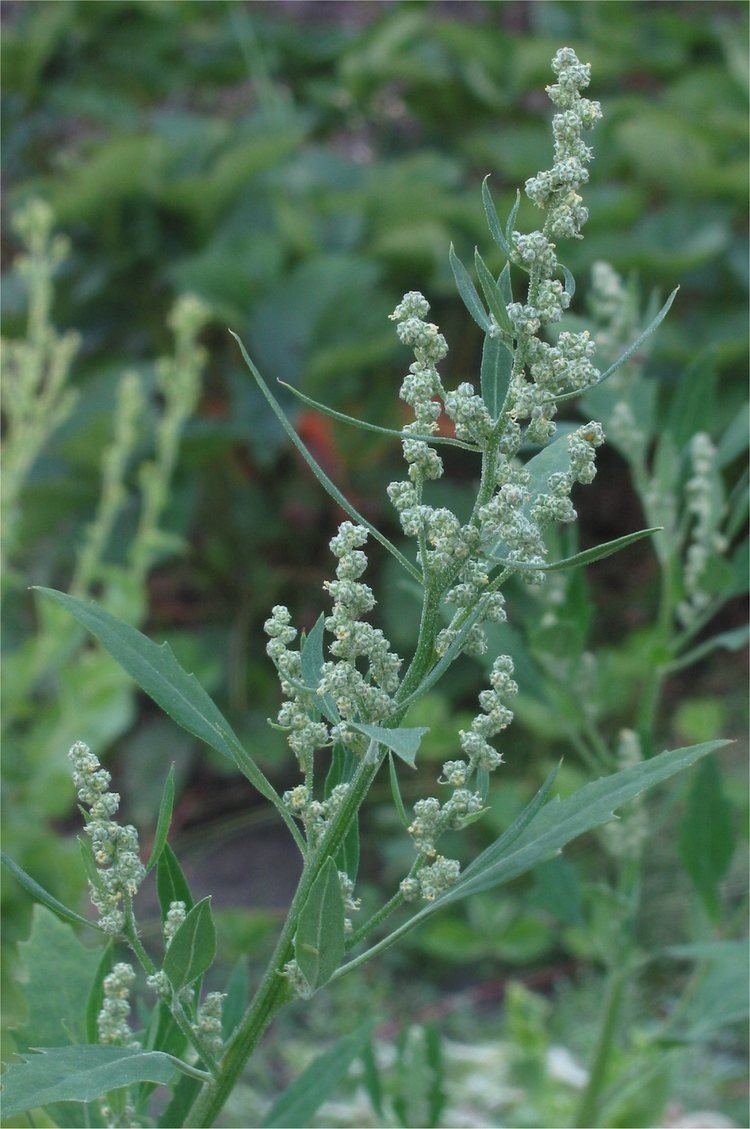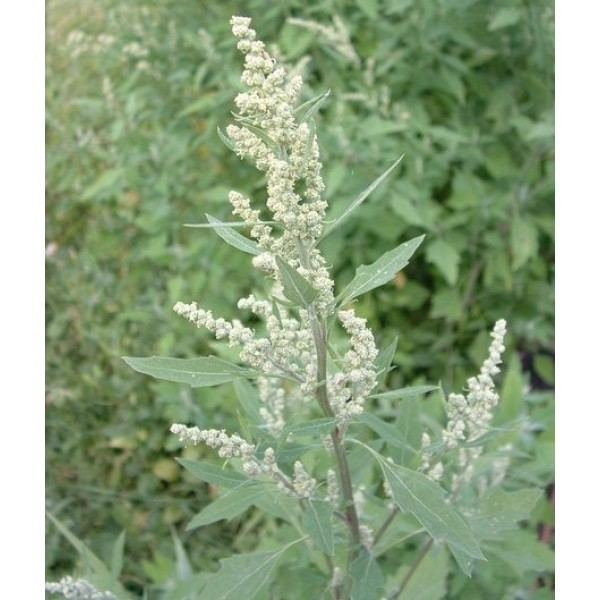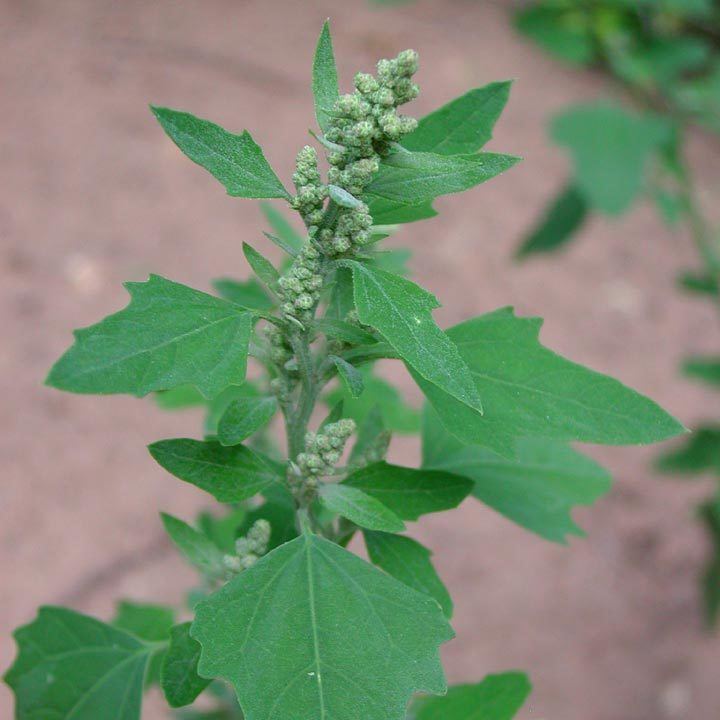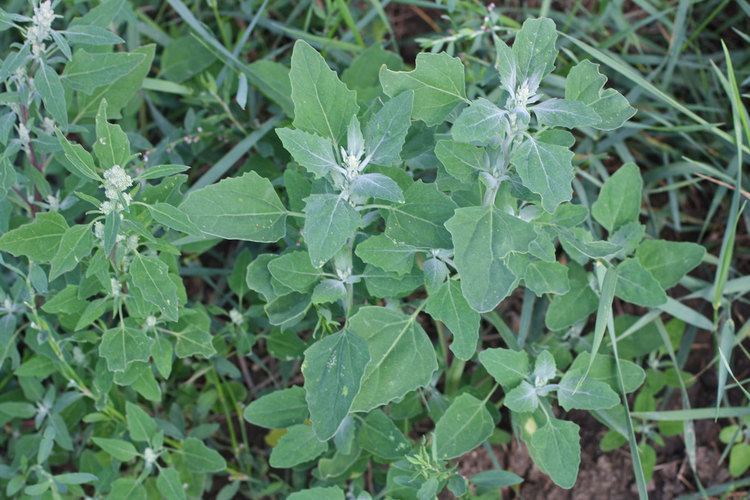Kingdom Plantae Family Amaranthaceae Scientific name Chenopodium album Rank Species | Order Caryophyllales Genus Chenopodium Higher classification Chenopodium | |
 | ||
Similar Common Chickenweed, Cleavers, Amaranth, Shepherd's Purse, Common Purslane | ||
Lambs quarter chenopodium album
Chenopodium album is a fast-growing weedy annual plant in the genus Chenopodium.
Contents
- Lambs quarter chenopodium album
- Lamb s quarters chenopodium album 2013 07 28
- Distribution
- Botany
- Taxonomy
- Regions where cultivated
- Potential impact on conventional crops
- Beneficial use in ecological pest control
- Food
- Animal feed
- Construction
- References
Though cultivated in some regions, the plant is elsewhere considered a weed. Common names include lamb's quarters, melde, goosefoot and fat-hen, though the latter two are also applied to other species of the genus Chenopodium, for which reason it is often distinguished as white goosefoot. It is sometimes also called pigweed, however, pigweed is also a name for a few weeds in the family Amaranthaceae,: it is for example used for the redroot pigweed (Amaranthus retroflexus).

Chenopodium album is extensively cultivated and consumed in Northern India as a food crop, and in English texts it may be called by its Hindi name bathua or bathuwa (बथुआ) (Marathi:चाकवत). It is called Pappukura in Telugu, Paruppukkirai in Tamil, Kaduoma in Kannada, Vastuccira in Malayalam, and Chakvit in Konkani.

Lamb s quarters chenopodium album 2013 07 28
Distribution

Its native range is obscure due to extensive cultivation, but includes most of Europe, from where Linnaeus described the species in 1753. Plants native in eastern Asia are included under C. album, but often differ from European specimens. It is widely introduced elsewhere, e.g. Africa, Australasia, North America, and Oceania, and now occurs almost everywhere in soils rich in nitrogen, especially on wasteland.
Botany

It tends to grow upright at first, reaching heights of 10–150 cm (rarely to 3 m), but typically becomes recumbent after flowering (due to the weight of the foliage and seeds) unless supported by other plants. The leaves are alternate and varied in appearance. The first leaves, near the base of the plant, are toothed and roughly diamond-shaped, 3–7 cm long and 3–6 cm broad. The leaves on the upper part of the flowering stems are entire and lanceolate-rhomboid, 1–5 cm long and 0.4–2 cm broad; they are waxy-coated, unwettable and mealy in appearance, with a whitish coat on the underside. The small flowers are radially symmetrical and grow in small cymes on a dense branched inflorescence 10–40 cm long.
Taxonomy

Chenopodium album has a very complex taxonomy and has been divided in numerous microspecies, subspecies and varieties, but it is difficult to differentiate between them. The following infraspecific taxa are accepted by the Flora Europaea:

Published names and synonyms include C. album var. microphyllum, C. album var. stevensii, C. acerifolium, C. centrorubrum, C. giganteum, C. jenissejense, C. lanceolatum, C. pedunculare and C. probstii.
It also hybridises readily with several other Chenopodium species, including C. berlandieri, C. ficifolium, C. opulifolium, C. strictum and C. suecicum.
Regions where cultivated
The species are cultivated as a grain or vegetable crop (such as in lieu of spinach), as well as animal feed in Asia and Africa, whereas in Europe and North America, it is commonly regarded as a weed in places such as potato fields.
Potential impact on conventional crops
It is one of the more robust and competitive weeds, capable of producing crop losses of up to 13% in corn, 25% in soybeans, and 48% in sugar beets at an average plant distribution. It may be controlled by dark tillage, rotary hoeing, or flaming when the plants are small. Crop rotation of small grains will suppress an infestation. It is easily controlled with a number of pre-emergence herbicides. Its pollen may contribute to hay fever-like allergies.
Beneficial use in ecological pest control
Chenopodium album is vulnerable to leaf miners, making it a useful trap crop as a companion plant. Growing near other plants, it attracts leaf miners which might otherwise have attacked the crop to be protected. It is a host plant for the beet leafhopper, an insect which transmits curly top virus to beet crops.
Food
The leaves and young shoots may be eaten as a leaf vegetable, either steamed in its entirety, or cooked like spinach, but should be eaten in moderation due to high levels of oxalic acid. Each plant produces tens of thousands of black seeds. These are high in protein, vitamin A, calcium, phosphorus, and potassium. Quinoa, a closely related species, is grown specifically for its seeds. The Zuni people cook the young plants' greens. Bathua seeds also double up for rice and dal. Once Napoleon Bonaparte is said to have relied on bathua seeds to feed his troops during lean times.
Archaeologists analysing carbonized plant remains found in storage pits and ovens at Iron Age, Viking Age, and Roman sites in Europe have found its seeds mixed with conventional grains and even inside the stomachs of Danish bog bodies.
In India, the plant is popularly called bathua and found abundantly in the winter season. The leaves and young shoots of this plant are used in dishes such as soups, curries, and paratha-stuffed breads, especially popular in Punjab. The seeds or grains are used in phambra or laafi, gruel-type dishes in Himachal Pradesh, and in mildly alcoholic fermented beverages such as soora and ghanti.
Animal feed
As some of the common names suggest, it is also used as feed (both the leaves and the seeds) for chickens and other poultry.
Construction
The juice of this plant is a potent ingredent for a mixture of wall plaster, according to the Samarāṅgaṇa Sūtradhāra, which is a Sanskrit treatise dealing with Śilpaśāstra (Hindu science of art and construction).
